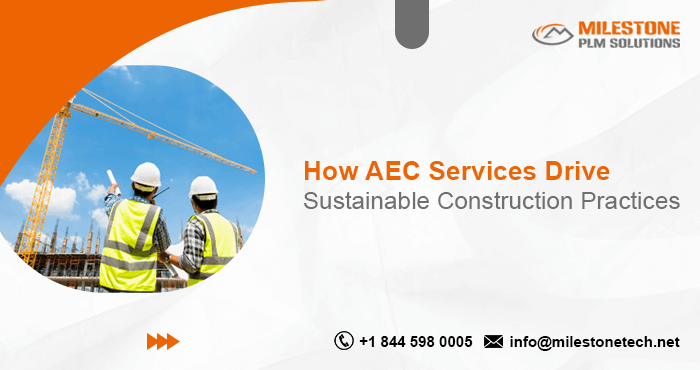How AEC Services Drive Sustainable Construction Practices

Sustainability has become a cornerstone of modern construction, and the Architecture, Engineering, and Construction (AEC) industry plays a pivotal role in driving this transformation. The need for environmentally friendly practices is no longer optional; it’s a necessity. AEC services are at the forefront of ensuring that sustainability is integrated into every phase of a construction project—from conceptual design to facility management. In this blog, we will explore how AEC services contribute to sustainable construction practices and why they are critical for a greener future.
Understanding AEC Services and Their Role
AEC services encompass a broad spectrum of activities, including architectural design, engineering, project management, and construction execution. These services are interconnected, working collaboratively to bring complex construction projects to fruition. By integrating sustainability principles into each of these facets, AEC professionals can minimize the environmental footprint of construction activities and create buildings that are efficient, durable, and eco-friendly.
Key Ways AEC Services Drive Sustainable Practices
Sustainable Design and Planning
Architects and engineers are at the heart of sustainable construction. Through innovative design strategies, AEC services focus on:
- Energy-efficient buildings: Leveraging passive design principles, such as natural ventilation, daylighting, and insulation, to reduce energy consumption.
- Smart material selection: Choosing materials with low embodied energy, high recyclability, and minimal environmental impact.
- BIM integration: Building Information Modeling (BIM) allows AEC professionals to simulate and optimize designs for sustainability, reducing waste and improving resource efficiency.
Incorporating Green Building Standards
AEC services facilitate compliance with green building certifications, such as LEED, BREEAM, and WELL. These frameworks provide guidelines for energy efficiency, water conservation, indoor environmental quality, and material sourcing. By adhering to these standards, AEC professionals ensure that projects meet or exceed sustainability benchmarks.
Lifecycle Assessment and Optimization
A holistic approach to sustainability requires considering the entire lifecycle of a building. AEC services employ tools and methodologies to:
- Assess environmental impact: Evaluate the carbon footprint of materials and construction processes.
- Optimize operational efficiency: Incorporate systems like renewable energy sources, energy-efficient HVAC, and smart building technologies to reduce long-term energy use.
- Plan for end-of-life: Design buildings with modularity and adaptability to facilitate deconstruction and material reuse.
Efficient Construction Practices
The construction phase is often resource-intensive, but AEC services help mitigate its impact through:
- Prefabrication and modular construction: Reducing waste and improving efficiency by manufacturing components offsite.
- Digital twin technology: Enabling real-time monitoring and optimization of construction processes.
- Construction waste management: Implementing recycling and reuse strategies to divert waste from landfills.
Smart Technologies for Sustainable Operations
Post-construction, AEC services extend their influence by integrating technologies that enhance building performance, such as:
- IoT and smart sensors: Monitoring energy and water usage to identify inefficiencies and optimize performance.
- Automation systems: Controlling lighting, HVAC, and other systems to minimize energy consumption.
- Predictive maintenance: Using data analytics to forecast and address potential issues, reducing downtime and resource use.
Challenges and Future Opportunities
While AEC services have made significant strides in promoting sustainability, challenges remain. These include high upfront costs, resistance to change, and the need for better collaboration among stakeholders. However, advancements in technology and growing awareness of environmental issues present immense opportunities to overcome these barriers.
Emerging trends include:
- AI and machine learning: Enhancing design precision and optimizing resource allocation.
- Carbon-neutral construction: Using carbon capture technologies and sustainable materials to achieve net-zero emissions.
- Circular economy principles: Emphasizing reuse, recycling, and sustainable sourcing throughout the construction process.
Conclusion:
AEC services are the linchpin of sustainable construction practices. By integrating innovative technologies, green building standards, and lifecycle optimization, they enable the creation of structures that are not only functional but also environmentally responsible. As the demand for sustainable construction grows, the role of AEC services will only become more critical in shaping a greener, more resilient future.
Sustainability in construction is not a destination but a continuous journey. Through the collaborative efforts of architects, engineers, and builders, AEC services will continue to push the boundaries of what is possible, driving the industry towards a brighter, sustainable tomorrow.
The AEC (Architecture, Engineering, and Construction) industry encompasses the planning, design, and construction of buildings, infrastructure, and other physical structures.
Globally, the AEC industry is valued at trillions of dollars, driven by urbanization and infrastructure development.
Structural engineering services focus on designing and analyzing structures like buildings, bridges, and towers to ensure strength, stability, and safety.
Follow Milestone PLM Solutions for Mechanical Industry Updates, CAD Tips and Global Mechanical News.
Milestone PLM Solutions with its exclusive delivery center in India is a global CAD, CAM & FEA services outsourcing partner serving the needs of the Mechanical, Millwork and Automotive industry since 2004. MILESTONE focuses on the unique needs of clients and believes in tackling real-life problems with efficiency, smooth and ease.
The MILESTONE team can assist you with Product Design, 3d Modeling, Drafting & detailing, Reverse Engineering, FEA Analysis and more. We support multiple software including AutoCAD, SolidWorks, Catia, NX, Inventor, Solidedge & Ansys etc. Our approach is to provide a dedicated team for each customer over ongoing project and deliver the quality output consistently.
With our state of art technology and large talent pool of Engineers, we are developing best in class solutions for our customers across the globe. We align with your culture and values to form unbreakable partnerships and are primed for success with over 100 employees and 150 customers in the US, Europe, India, and Asia.
You can email us at info@milestonetech.net and can log in to our website www. milestonetech.net to know more about our services and our work portfolio or contact us on +1-844-598-0005
